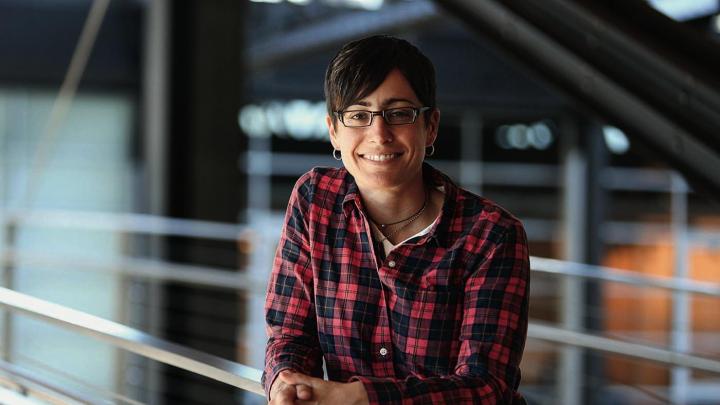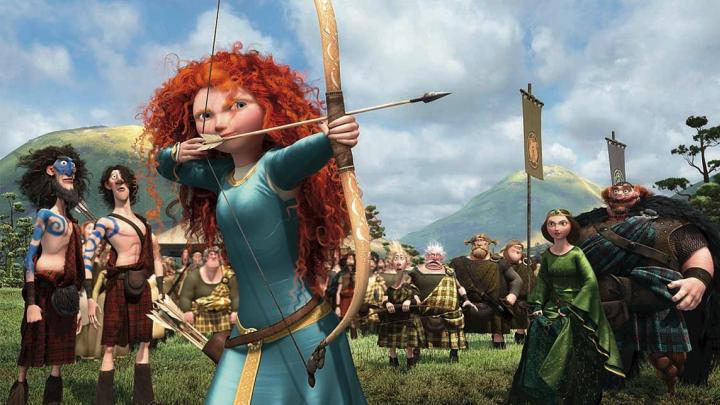You’ve probably seen a great deal of Danielle Feinberg’s work without knowing it—in fact, it might be more accurate to say that you’ve seen a great deal by virtue of her work. Feinberg ’96 is a director of photography at Pixar, where for almost a decade and a half she’s designed lighting for many of the studio’s most successful animated worlds, from A Bug’s Life (1998) and Monsters, Inc. (2001) through Wall-E (2008) and Brave (2012).
Feinberg’s role is unusually specialized. Whereas the cinematographer for a live-action film is in charge of both camera and lighting, Pixar’s production system splits these responsibilities between two people, one handling the movement, angle, and focus of the virtual camera near the beginning of the pipeline, the other handling lighting at the very end. Rather than recording in real-time, every element of Pixar’s animations—the characters, their actions, and the virtual worlds they inhabit—is programmed into a computer before being “rendered” into moving images; as a result, the process is uniquely additive, each stage in the composition building on and inflecting previous layers. Lighting is the final step: each sequence is programmed without lighting, with Feinberg synthesizing the proper amounts of natural and artificial light, selecting the angle of each virtual object, adding tasteful cloud or tree cover when necessary, and accentuating certain hues to match the visual texture and ambiance to the action. Feinberg describes her job as “mind-melding” with her counterpart in camera “to find the magic pieces to pull it all together.”
But as the capabilities of computer graphics asymptotically approach realism, Feinberg is careful to note that verisimilitude is neither Pixar’s aim nor hers: “Realism has never been a goal…You can just get pulled out of ‘realistic’ so quickly.” Indeed, animated worlds that mirror the physical world too precisely can be jarring, often veering into an “uncanny valley” which audiences find unsettling and hard to accept. Feinberg and her colleagues thus design every element of their digital worlds in accordance with the tone of the story they are telling. This approach often makes deviating from reality— exaggerating certain characteristics and suppressing others—more effective than mimicking it. That could mean leaving a basketball hanging in the air for an extra tenth of a second, giving a character’s hair just a little bit too much bounce, or suspending dust motes in a beam of almost-too-perfect afternoon sunlight. “What we really want to create is a certain feel,” Feinberg explains. “And it’s so much more fun to do the stylized thing anyway.”
Feinberg’s passion is equal and complementary parts aesthetic and technical. When asked about her biggest influences, she extols the work of cinematographer Roger Deakins and the color palette of American Beauty in the same breath as she recounts her earliest programming experiences. Growing up in Colorado, she attended an after-school program that taught elementary-school students how to create digital imagery with the educational programming language LOGO. When she arrived at Harvard, recruited to play softball, Feinberg intended to pursue mechanical engineering. “I decided, after going to engineering camp, that that was how you invented things,” she says with a laugh. But she was immediately drawn to courses in computer science, where she could explore her longstanding programming hobby more seriously. After only a month, she says, “I couldn’t imagine why I wouldn’t just major in computer science…a thing I already loved and had been doing.”
The department offered only one computer graphics course at the time, so Feinberg explored her cutting-edge interests piecemeal, cobbling together classes in computer science and art, as well as work in the campus “Graphics Group” of students pursuing independent studies with faculty supervision. In the process, she started to notice the sharp gender disparity in her field. Her experience of “being one of the very few girls in most math, science, or programming classes, how lonely and isolating that is”—and of “how much it takes to overcome that”—has driven her work with the nonprofit advocacy organization Girls Who Code, which strives to encourage girls’ interest in computer science. “Girls are getting the message from teachers or parents—people who don’t even know they’re giving them the message—that they shouldn’t be doing that thing. And I can’t stand when someone loves something and they’re told that they shouldn’t do it.”
Three semesters in the classroom of Joe Marks ’82, Ph.D. ’91, a lecturer in computer science with whom Feinberg has maintained a friendship ever since, proved a turning point: he introduced her to digital animation—and to Pixar—when he screened several of the company’s shorts in a computer-graphics course during her junior year. These were “really the first computer animation I had ever seen,” she recalls. “It completely captured my imagination: ‘All this math, science, and code I’ve been learning can create a whole different world inside the computer, and you can set a story there and build these characters? That’s insane.’ A month later, Toy Story came out, and as a class we all went to see it. I thought, ‘Man, I’ve got to do that someday. I’ll work really hard, and maybe by the time I’m 35, I’ll work [at Pixar].’”
Things moved much faster than that. Feinberg was working there at 22, beginning as a “render wrangler” (technicians who manage a massive library of data and images) before getting her first taste of lighting work on A Bug’s Life. It was then she realized, “That was what I really loved. It’s the final image where the world comes to life —it’s the final creative step.” For Feinberg, it’s also the most crucial step, the point when the smallest detail in the code can make a tremendous difference to the audience: “You put the lights in, and suddenly, it becomes believable that they could go into that world.”











